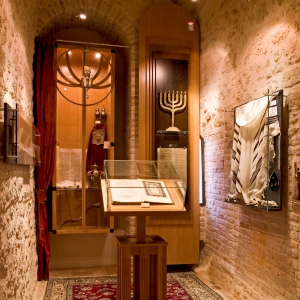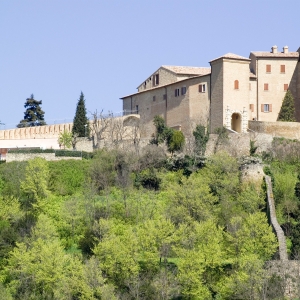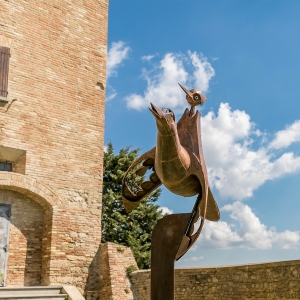The Fortress of Bertinoro, which today houses the University Residential Centre and the Interfaith Museum, was presumably built in the mid-10th century. A placitum, preserved in the Ravenna Archiepiscopal Archive, dated 27 November 995, mentions the presence of a donjon, built in masonry, on the highest part of the Bertinoro hill. In 1004, the Fortress of Bertinoro was entrusted as a feud by the archbishop of Ravenna to Ugo degli Onesti, founder of the comital lineage that ruled Bertinoro until the end of the 12th century. During the struggle between the Communes and Emperor Frederick I Barbarossa, the Countess of Bertinoro
read more
Aldruda Frangipane had the fortress enlarged, building the spaces where the Interfaith Museum is today. After the extermination of the comital lineage, between the end of the 12th and the beginning of the 13th century, the Rocca was dominated by some of the most important Ghibelline families of Romagna. The Ordelaffi, lords of Forlì and proud opponents of the expansionist policy of the Papacy in Romagna, welcomed Dante Alighieri to the Fortress of Bertinoro during the first years of his exile. It is plausible to affirm that Dante's stay in Bertinoro was a lasting one, as demonstrated by the numerous references to men and characters from local history: among them, the judge Guido del Duca, the protagonist of the 14th canto of Purgatory. In the mid-fourteenth century, Cardinal Egidio Albornoz, engaged in the reconquest of Romagna to the Papacy, was present in the Fortress of Bertinoro. From 1377, the fortress of Bertinoro was entrusted as a feud to the Malatesta family of Cesena, who, together with Domenico known as Novello, who retired to the fortress in 1442, restructured the building. On Novello's death (1465), Bertinoro returned under the direct control of the Church until 1499, when Pope Alexander VI assigned the fortress as a feud to his son Cesare Borgia.With the subsequent fall of the Borgia family, the fortress of Bertinoro also gradually lost its military power.From 1584 it became an Episcopal seat on the initiative of Bishop Caligari, who had renovation and conservative restoration work carried out.The rebuilding of the stables, the raising of the flats and the installation of the belfry on the entrance tower dates back to this period, and the work lasted until 1599.Further alterations were also made by subsequent bishops, until 1800 when the dwindling financial resources could no longer cover the maintenance costs, so much so that in 1927 the bell tower collapsed, also sweeping away part of the entrance.Tower rebuilt in 1931 with contributions from the municipality and the population, lower and without a bell.The tower was rebuilt in 1931 with contributions from the municipality and the population, lower and without a bell. The tower was heavily damaged during the Second World War, when it was hit by Anglo-American bombing in October 1944 and the interior of the fortress was almost completely destroyed.Post-war restoration work lasted until 1949, with the addition of significant changes Following the unification of the dioceses of Forlì and Bertinoro, which ended in 1986, the fortress was abandoned and major restoration work was carried out between 1998 and 2002 to reuse the building for museum, cultural and university purposes.
shorten










